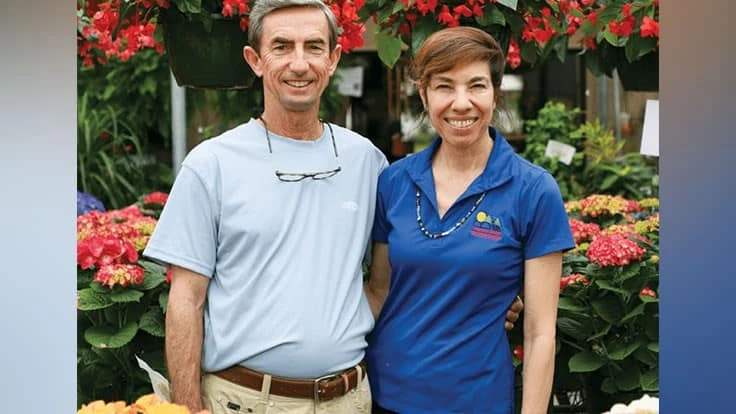

If Tim and Lisa King aren’t working at Forest Lake Greenhouses, the husband and wife horticulturalists are probably tending to their home garden in Florence, South Carolina. Their shared love of plants brought them together more than 30 years ago, and continues to drive their business today.
Tim, a Florence native, took a horticulture class at the local career center during his junior year of high school. When a nearby nursery was looking for part-time help, the instructor recommended Tim — landing him his first job in the greenhouse industry.
He continued working there at the nursery for a year after graduating, and then moved to a large wholesale grower in Charleston. Meanwhile, Lisa migrated to the same company after graduating from Penn State with a horticulture degree. She worked in sales, while Tim served as assistant grower. The two plant-lovers met, started dating and married.
“We came back to my hometown with ideas of starting our own business,” Tim says, “and we never looked back.”
Named after a nearby lake, Forest Lake Greenhouses took shape on the corner of a former cornfield in the summer of 1989. The Kings built two Quonset greenhouses and planted their first poinsettia crop — but less than three months later, Hurricane Hugo whipped through the coast as a Category 4 storm with wind speeds topping 140 mph.
“We just tied ropes over the greenhouse to try to keep the plastic on,” Tim says. “Luckily, we didn’t have any damage, so everything was fine. We grew that first crop of poinsettias — I think it was 2,000 plants — and sold them all that first year.”
After a that stormy start, Forest Lake Greenhouses continued to grow and evolve under the leadership of the Kings.

Retail growth
The Charleston operation, where Tim and Lisa met, mostly grew blooming potted plants for the florist industry. They initially adopted the same focus at Forest Lake — but added a small retail store to supplement their wholesale production. As new crops came to the retail market, their business shifted drastically.
“We started out mostly growing potted crops and just servicing flower shops,” Tim says. “Then, vegetative plant material came along in the 90s, introducing a whole different class of plant material for the garden center industry. Learning to grow those crops was totally different from the potted crops I’d been growing, so that’s been a huge shift in production.”
While Forest Lake still grows a lot of potted crops, including hydrangeas and poinsettias, they’re now growing more bulbs and vegetative plants for containers and colorful landscapes, while servicing more garden centers —– including their own.
Since starting out as a predominantly wholesale operation, Forest Lake’s business has shifted to 70% retail and 30% wholesale, with Lisa managing retail operations, while Tim, as head grower, oversees production.
“She tells people [that] the way we’ve survived 30 years is that I stay in the back and she stays in the front,” Tim says, laughing. “But we work great together, and we’ve got a wonderful staff that’s been with us for a long time.”
They each have about 10 to 12 employees in their department, including a handful of people who have been with the company for 28 years. During slower retail times, it’s not uncommon for Lisa’s staff to help Tim plant plugs in the greenhouse. After he finishes his tasks on Saturday afternoons, he’s likewise helping Lisa in the store.
“I love getting to watch the finished product go out the door,” he says. “You learn what customers are asking for, and it’s very satisfying to see customers enjoy the product we’re producing.”

Efficient operations
The other big change that Tim has noticed throughout his 40-year career is the rising cost of operations.
“The cost of growing crops has gone up significantly,” he says, citing the prices of soil, pots, freight and labor. “We’re trying to produce crops [more efficiently] so we can still be profitable.”
Small updates over time have increased the efficiency of Forest Lake’s operation, which now spans 50,000 square feet of covered production space and another two acres of outdoor production.
For example, adding a liftgate to their delivery truck 15 years ago was “a huge boost to our business,” Tim says, because it allowed them to easily load carts to supply larger garden centers.
Likewise, a monorail system in the greenhouse makes it easier to move products around quickly, while automated irrigation helps reduce the need for manual watering.
“Anytime you can invest in automation and equipment, you will make yourself more efficient, plus you’ll have happier employees because you’re giving them the tools to work with,” Tim says.
By supporting the staff to produce and sell healthy plants, Tim and Lisa continue to provide their customers with a wide selection of colorful blooms and family-friendly service.
“I’m just very blessed to be in the plant business,” Tim says. “I couldn’t think of doing anything else.”

Explore the May 2020 Issue
Check out more from this issue and find your next story to read.
Latest from Greenhouse Management
- Anthura acquires Bromelia assets from Corn. Bak in Netherlands
- Top 10 stories for National Poinsettia Day
- Langendoen Mechanical hosts open house to showcase new greenhouse build
- Conor Foy joins EHR's national sales team
- Pantone announces its 2026 Color of the Year
- Syngenta granted federal registration for Trefinti nematicide/fungicide in ornamental market
- A legacy of influence
- HILA 2025 video highlights: John Gaydos of Proven Winners





